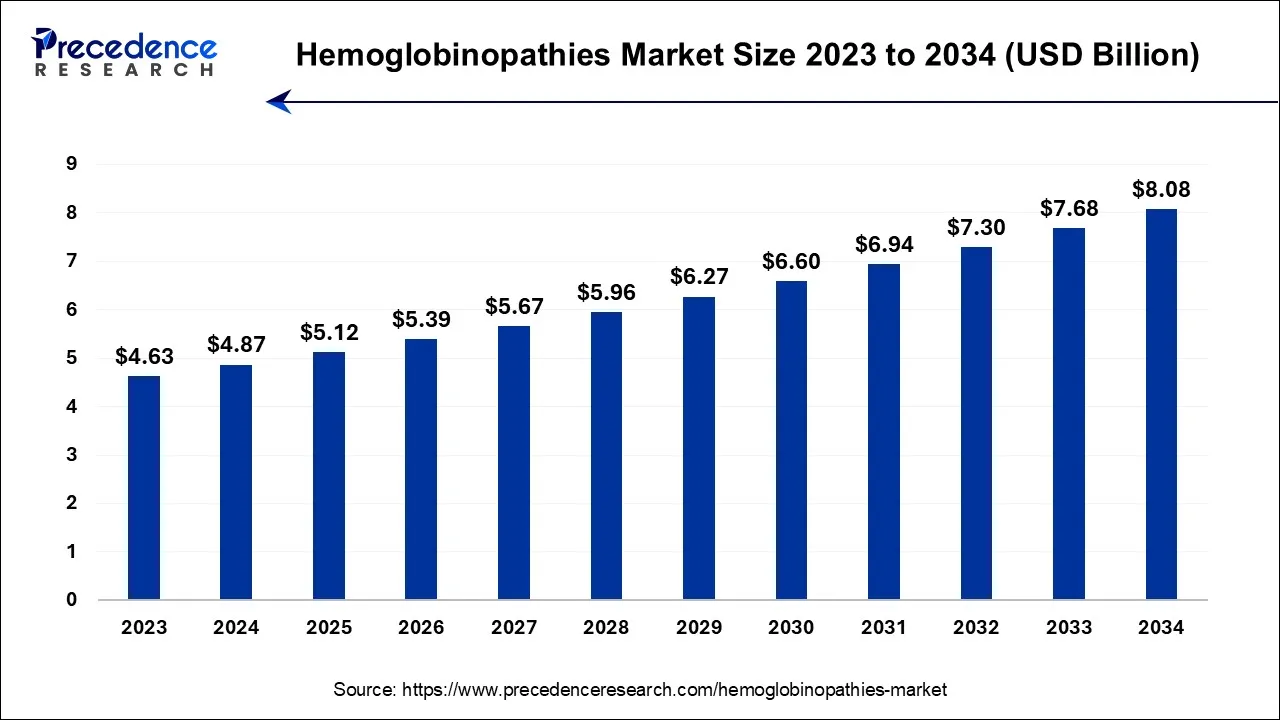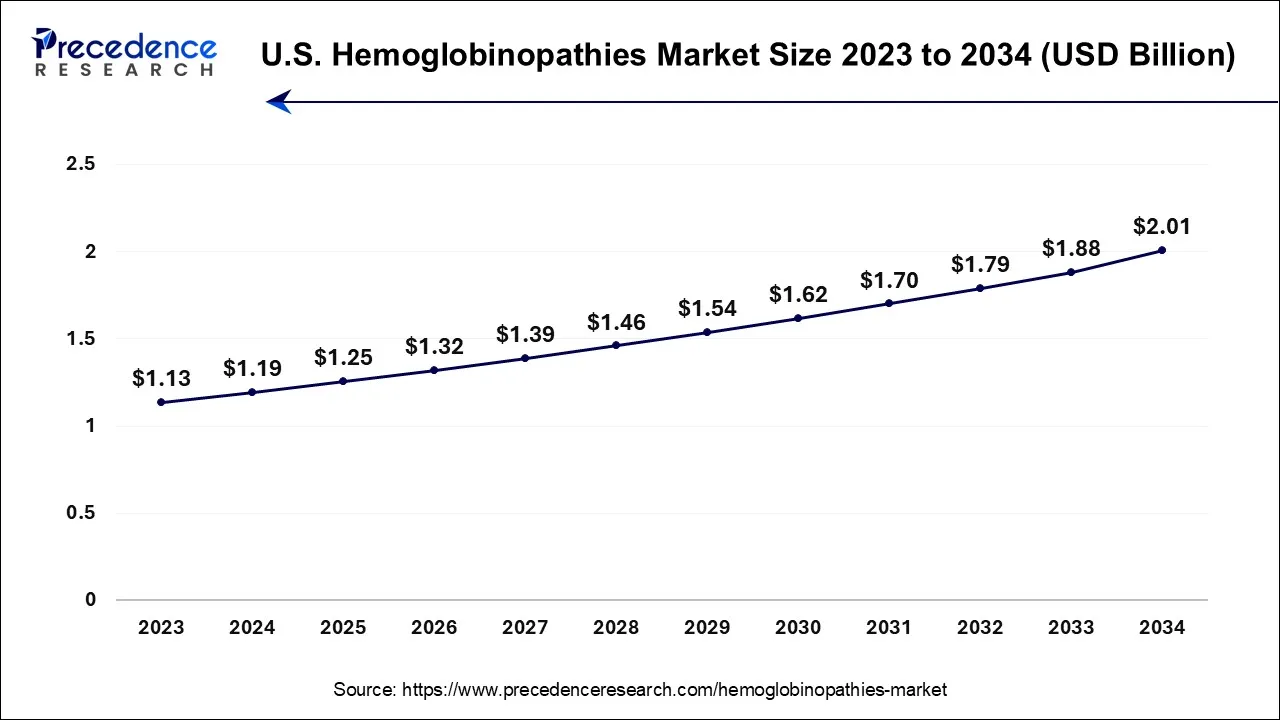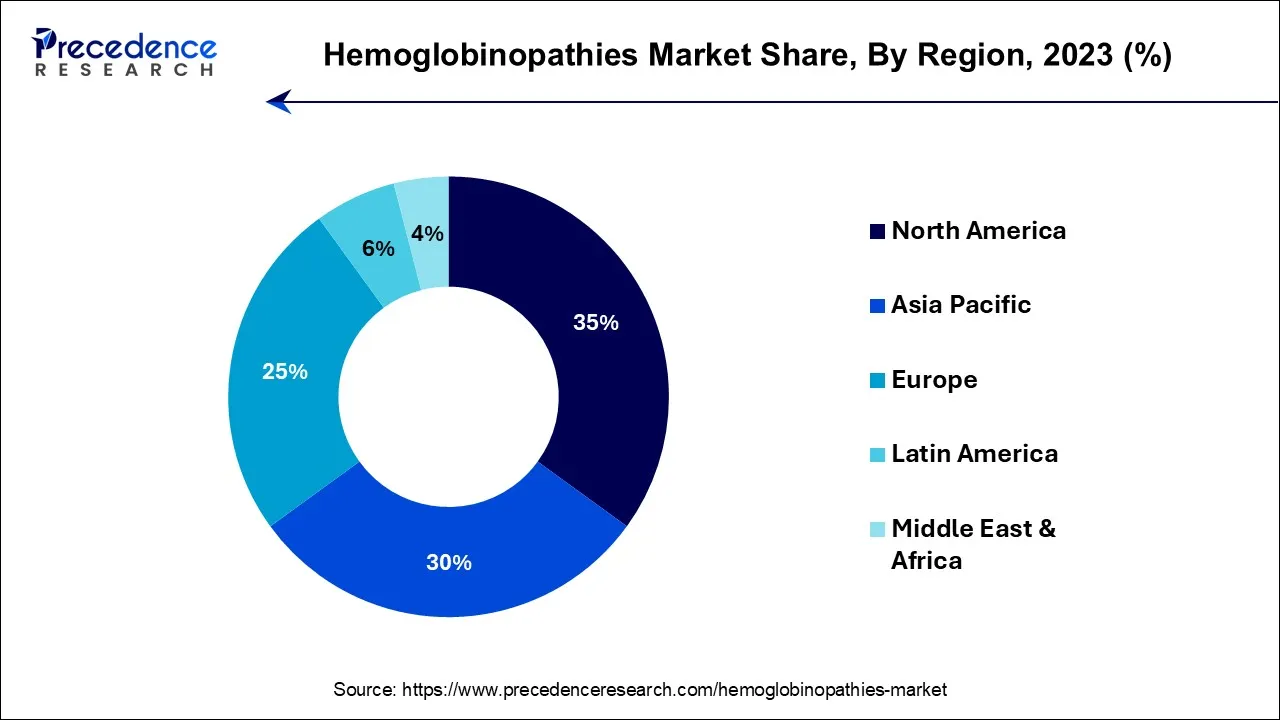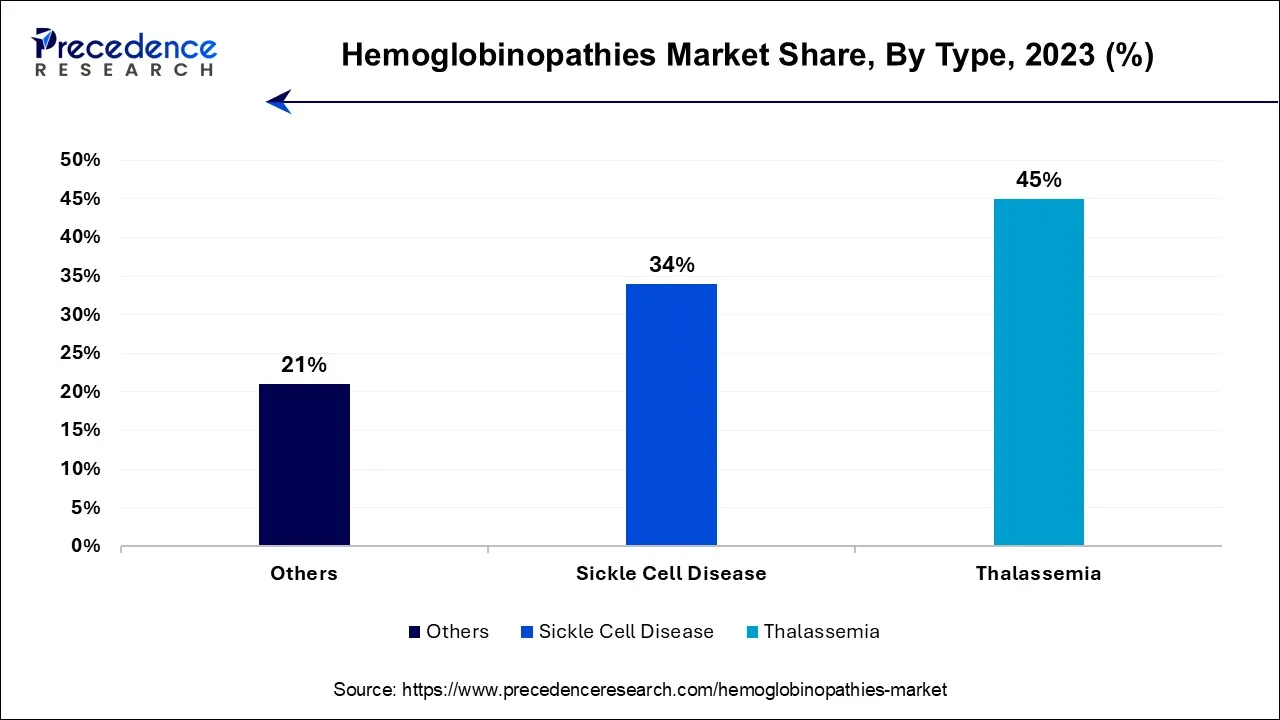The global hemoglobinopathies market size is calculated at USD 4.87 billion in 2024, grew to USD 5.12 billion in 2025, and is predicted to hit around USD 8.08 billion by 2034, poised to grow at a CAGR of 5.2% between 2024 and 2034. The North America hemoglobinopathies market size accounted for USD 1.70 billion in 2024 and is anticipated to grow at the fastest CAGR of 5.37% during the forecast year.
The global hemoglobinopathies market size is expected to be valued at USD 4.87 billion in 2024 and is anticipated to reach around USD 8.08 billion by 2034, expanding at a CAGR of 5.2% over the forecast period from 2024 to 2034.

The U.S. hemoglobinopathies market size is accounted for USD 1.19 billion in 2024 and is projected to be worth around USD 2.01 billion by 2034, poised to grow at a CAGR of 5.38% from 2024 to 2034.

North America has held largest revenue share 35% in 2023. North America commands a significant share in the hemoglobinopathies market due to various factors. The region benefits from advanced healthcare infrastructure, increased awareness, and a high prevalence of hemoglobin disorders, particularly sickle cell disease. Robust research and development initiatives, government support, and collaborations between pharmaceutical companies and research institutions contribute to the development of innovative therapies.
Additionally, favorable reimbursement policies and a well-established healthcare system enhance patient access to treatments. The presence of key market players and clinical trials further solidifies North America's dominance in the hemoglobinopathies market.

Asia-Pacific is estimated to observe the fastest expansion. Asia-Pacific commands a significant share in the hemoglobinopathies market due to a high prevalence of these disorders in the region. The region has a large population, including many countries with elevated carrier rates of hemoglobinopathies, such as thalassemia and sickle cell disease.
Additionally, improving healthcare infrastructure, rising awareness, and increasing investments in research and treatment options have contributed to the market's growth. Moreover, government initiatives and collaborations with pharmaceutical companies have facilitated access to innovative therapies, making Asia-Pacific a major player in addressing hemoglobinopathies on a global scale.
The hemoglobinopathies market is the dynamic arena within the pharmaceutical and healthcare sectors dedicated to tackling hemoglobin disorders such as sickle cell disease and thalassemia. This encompassing market is flourishing due to heightened awareness, cutting-edge diagnostic tools, and revolutionary therapies like gene editing and gene therapy. Pharmaceutical enterprises are fervently innovating to develop drugs and interventions aimed at alleviating symptoms, elevating the quality of life for patients, and potentially offering definitive solutions. The market's growth trajectory is primarily fueled by the escalating global prevalence of these conditions, particularly in regions with elevated carrier frequencies, including Africa, the Middle East, and specific parts of Asia. Consequently, this realm stands as a pivotal frontier for intensive medical research and substantial investment.
The hmoglobinopathies market, nestled within the pharmaceutical and healthcare sectors, is an emerging realm dedicated to tackling hemoglobin disorders like sickle cell disease and thalassemia. This market's expansion hinges on several pivotal elements, including heightened public awareness, breakthroughs in diagnostic modalities, and revolutionary treatment paradigms such as gene editing and gene therapy. Consequently, pharmaceutical entities are fervently channeling resources into pioneering drug formulations and interventions aimed at alleviating symptoms, augmenting patient quality of life, and potentially ushering in curative therapies.
A conspicuous trend propelling the hemoglobinopathies market is the escalating global prevalence of these conditions, particularly in regions grappling with elevated carrier rates, such as Africa, the Middle East, and specific Asian locales. This demographic shift underscores the pressing need for efficacious treatments and precise diagnostics, galvanizing substantial investments in research and development. The trajectory of the market is further swayed by a heightened emphasis on personalized medicine and precision therapies, promising to redefine the landscape of hemoglobinopathy management and treatment.
Nevertheless, the Hemoglobinopathies market grapples with formidable challenges, chiefly stemming from the intricate genetic underpinnings of these disorders and the requisite tailoring of therapies to individual patients. Regulatory complexities and the formidable costs associated with pioneering treatments present formidable entry barriers for smaller players in the sector. Furthermore, disparities in healthcare access and awareness, particularly in marginalized regions, pose impediments to the widespread acceptance of novel therapies.
In the face of these formidable obstacles, the market also teems with opportunities ripe for exploration by enterprises and healthcare institutions alike. Collaborative initiatives between pharmaceutical entities, research centers, and advocacy organizations hold the potential to expedite the development of pioneering treatments. Additionally, the surging interest in rare diseases and orphan drug development has spotlighted hemoglobinopathies research, fostering heightened investment and inquiry.
Companies demonstrating adeptness in navigating these challenges while engineering effective treatments are poised to thrive in a market brimming with growth potential and the ability to usher in transformative improvements in the lives of individuals grappling with these conditions.
In summation, the hemoglobinopathies market is poised for substantial expansion, buoyed by an upswing in awareness, diagnostic innovations, and progressive treatment modalities. While challenges loom, including regulatory intricacies and healthcare disparities, the market's landscape beckons as a promising arena for innovators and researchers to forge groundbreaking treatments and elevate the wellbeing of those affected by these intricate disorders.
| Report Coverage | Details |
| Growth Rate from 2024 to 2034 | CAGR of 5.2% |
| Market Size in 2024 | USD 4.87 Billion |
| Market Size by 2034 | USD 8.08 Billion |
| Largest Market | North America |
| Base Year | 2023 |
| Forecast Period | 2024 to 2034 |
| Segments Covered | By Type, By Therapy, and By Distribution Channel |
| Regions Covered | North America, Europe, Asia-Pacific, Latin America, and Middle East & Africa |
Innovative therapeutic approaches
Innovative therapeutic methodologies are propelling remarkable growth within the hemoglobinopathies market. This sector is currently undergoing a transformative evolution, with avant-garde approaches such as gene editing and gene therapy poised to reshape the therapeutic landscape for hemoglobin disorders like sickle cell disease and thalassemia. Gene editing techniques, exemplified by the potent CRISPR-Cas9 system, enable highly precise modifications to malfunctioning hemoglobin genes, offering the alluring prospect of potential cures. Complementing this, gene therapy entails the introduction of fully functional genes into patients, addressing the root causes of these conditions.
These pioneering strategies not only hold the potential to mitigate symptoms but also promise enduring, if not permanent, relief, marking an extraordinary milestone in patient care. The magnetic appeal of these innovative therapies has ignited substantial research investments, fostering a dynamic ecosystem where biotechnology enterprises, pharmaceutical entities, and research institutions engage in deep collaboration to advance and refine these groundbreaking treatments.
As these therapies navigate rigorous clinical trials and secure regulatory greenlights, they carry the potential to dramatically elevate the quality of life for individuals grappling with hemoglobinopathies. Consequently, they stand as formidable drivers propelling market expansion while fundamentally enhancing the well-being of patients burdened by these conditions.
Complex genetic nature
The intricate genetic complexity inherent in hemoglobinopathies poses a significant impediment to the expansion of the market. These conditions, encompassing disorders like sickle cell disease and thalassemia, emerge from convoluted genetic mutations spanning multiple genes. This intricate genetic landscape imposes substantial hurdles for researchers and pharmaceutical enterprises striving to craft efficacious treatments.
The development of therapies capable of precisely targeting and rectifying specific genetic mutations in individual patients demands a profound mastery of genetics and molecular biology. The multifaceted array of genetic aberrations within these disorders necessitates highly customized and individualized approaches, which can be both time-intensive and financially burdensome to devise. Furthermore, the complexities inherent in the genetic foundations of these disorders mandate stringent safety evaluations and protracted monitoring of potential adverse effects, thereby further extending the timelines and expenses associated with ushering innovative treatments to market.
The intricate genetic milieu also presents challenges in patient identification, diagnosis, and the selection of appropriate treatment strategies, as each patient's genetic profile is unique. Consequently, the intricate genetic nature of hemoglobinopathies serves as a formidable obstacle, complicating the development, approval, and accessibility of pioneering therapies, thereby constraining the growth potential of the market.
Rare disease research
Rare disease research is opening up significant opportunities within the hemoglobinopathies market. Hemoglobinopathies, including sickle cell disease and thalassemia, are categorized as rare diseases due to their relatively low prevalence. This classification has led to a surge in interest and investment in rare disease research, benefiting the hemoglobinopathies sector in several ways.
Governments and healthcare organizations worldwide are increasingly recognizing the importance of addressing rare diseases, prompting the allocation of funding and resources specifically for research and development in this area. This influx of financial support has propelled advancements in understanding the genetic and molecular complexities of hemoglobinopathies.
Moreover, the orphan drug designation, which is often granted to treatments for rare diseases, provides regulatory incentives and extended market exclusivity for pharmaceutical companies, making the Hemoglobinopathies market more attractive for investment. As a result, the focus on rare disease research has spurred innovation, accelerated clinical trials, and fostered collaborations among academia, industry, and advocacy groups, ultimately offering new hope and improved prospects for individuals affected by hemoglobinopathies.
According to the type, the thalassemia segment has held 45% revenue share in 2023. Thalassemia holds a major share in the hemoglobinopathies market due to its higher prevalence compared to other hemoglobin disorders, such as sickle cell disease. Thalassemia is a genetic condition prevalent in regions like the mediterranean, Asia, and parts of Africa. Its relatively higher incidence rates contribute to a larger patient population, driving demand for diagnostic tests, treatments, and research. Additionally, advancements in thalassemia therapies, including blood transfusions, iron chelation therapy, and potential curative approaches like gene therapy, have further bolstered its prominent position in the hemoglobinopathies market.

The sickle cell disease segment is anticipated to expand at a significantly CAGR of 6.7% during the projected period. Sickle cell disease (SCD) commands a significant growth in the hemoglobinopathies market due to its higher prevalence and clinical severity. It affects millions globally, particularly in regions with high carrier rates. The pressing need for effective treatments, coupled with advancements in gene therapy and gene editing, has drawn substantial investment and research into SCD. Regulatory incentives, orphan drug status, and patient advocacy efforts have also contributed to the prominence of SCD within the market. As a result, it holds major growth as researchers and pharmaceutical companies focus on developing innovative therapies for this challenging and widespread hemoglobinopathy.
In 2023, the monoclonal antibody medication segment had the highest market share of 32% on the basis of the therapy. The monoclonal antibody medication category's prominent share in the hemoglobinopathies market can be attributed to its precision-focused approach. Monoclonal antibodies possess the exceptional capability to selectively target specific disease-related molecules, offering a highly tailored treatment strategy. Their established efficacy in mitigating complications and relieving symptoms associated with hemoglobinopathies has elevated them as the preferred therapeutic choice.
Moreover, ongoing research and development initiatives are consistently broadening the spectrum of available monoclonal antibody therapies, further solidifying their pivotal role in the market as a dynamic and continually evolving treatment avenue for these intricate genetic conditions.
The hydroxyurea is anticipated to expand at the fastest rate over the projected period. The dominance of the hydroxyurea segment in the hemoglobinopathies market can be attributed to its well-established reputation as a treatment for conditions like sickle cell disease. Having received approval and showcased its efficacy over many years, hydroxyurea stands out as a reliable option for reducing the frequency and severity of symptoms.
Additionally, its cost-effectiveness relative to newer, innovative therapies is a key factor. With a lengthy track record of use, affordability, and proven advantages, Hydroxyurea remains the preferred choice, particularly in regions where healthcare resources are limited, consolidating its substantial presence in the hemoglobinopathy treatment market.
The drug stores and retail pharmacy segment held the largest revenue share of 44% in 2023. The drug stores and retail pharmacy segment commands a significant share in the hemoglobinopathies market due to its accessibility and patient-centric approach. These outlets are widely distributed, ensuring that patients with hemoglobin disorders can easily access medications, specialized supplements, and medical supplies. Moreover, pharmacists play a pivotal role in patient education and compliance, offering valuable guidance and support. As a result, this segment becomes a critical touchpoint for individuals seeking treatment and management solutions for hemoglobinopathies, contributing substantially to the overall market share.
The online providers segment is anticipated to grow at a significantly faster rate, registering a CAGR of 7.9% over the predicted period. The online providers segment holds a significant share in the hemoglobinopathies market due to several factors. The increasing availability and accessibility of healthcare information on the internet have empowered patients and caregivers to seek online resources for disease management, treatment options, and support. Online platforms offer a convenient way to access information, connect with healthcare professionals, and find patient communities.
Additionally, telemedicine services have gained prominence, allowing patients to consult with specialists remotely. This shift towards online healthcare solutions has been further accelerated by the COVID-19 pandemic, driving the Online Providers segment's growth in the hemoglobinopathies market.
Segments Covered in the Report
By Type
By Therapy
By Distribution Channel
By Geography
For inquiries regarding discounts, bulk purchases, or customization requests, please contact us at sales@precedenceresearch.com
No cookie-cutter, only authentic analysis – take the 1st step to become a Precedence Research client